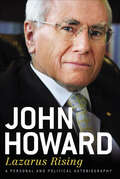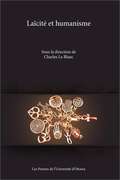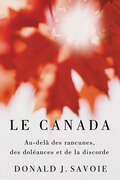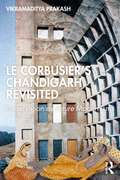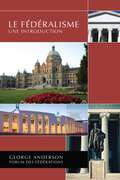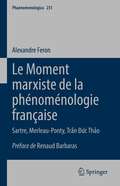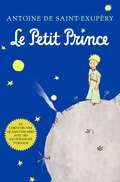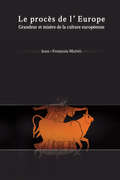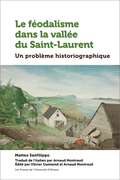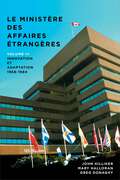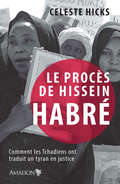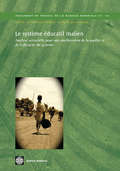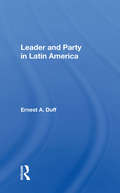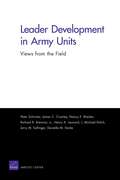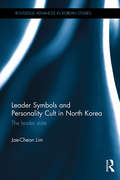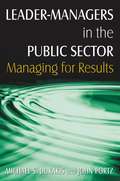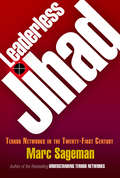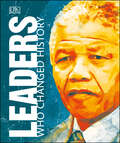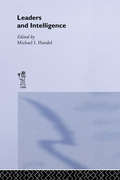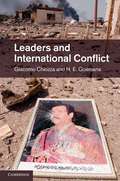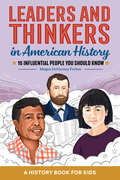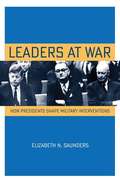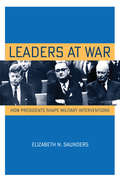- Table View
- List View
Lazarus Rising: A Personal and Political Autobiography
by John HowardJohn Howard spent decades under media scrutiny, and while his credentials as a political leader, devoted family man and sports tragic are beyond dispute, in this autobiography he reveals much more about himself. In Lazarus Rising, Howard traces his personal and political journey, from childhood in the post-World War II era through to the present day, painting a fascinating picture of a changing Australia. We see the youngster who had to overcome serious deafness and who latched onto the family passion for current affairs and politics. From school debating, to a legal career, to the Liberal Party and life with Janette, it all seemed such a natural progression. Yet no one would say that Howard had it easy; not when his own colleagues sidelined him . . . twice. An economic radical and social conservative, John Howard's ideology united many Australians and divided just as many others. Long before he attained the role of prime minister, he first had to convince his fellow Liberals that he was the man they needed. To do that, he had to tough it out; it took several attempts and many years biding his time. When he finally got his turn to take on the ALP, he proved wrong all his doubters, and showed a whole nation that it had been a mistake ever to underestimate John Howard. He led the Liberal Party to victory in four elections and became the second-longest-serving PM in the nation's history.Lazarus Rising is history seen through the eyes of the ultimate insider; an account of a 30-year political career. No prime minister of modern times has reshaped Australia and its place in the world as forcefully as John Howard. As part of his reform agenda he privatized Telstra, dismantled excessive union power and compulsory trade union membership, instituted the unpopular Goods and Services Tax, and established the ‘work for the dole' scheme. Then there are the insights into political leadership and character, the stuff that drives history. Without his deep reserves of resilience - and the support of a strong wife and loving family - there would have been no Prime Minister John Howard walking the world stage. He tells us how he responded on issues vital to Australia, such as gun control, the aftermath of 9/11, Iraq and the rising tide of asylum-seekers. He also shares his thoughts on his former Treasurer and leadership aspirant, Peter Costello, and the Rudd-Gillard debate.Lazarus Rising takes us through the life and motivations of John Howard and through the forces which have changed and shaped both him and the country he led for 11 years.
Laïcité et humanisme (Philosophica)
by Charles Le BlancLaïcité et humanisme : un titre et deux mots de grande actualité tant au Québec qu’ailleurs dans le monde. Cet ouvrage, avec des contributions d’acteurs clés qui alimentent le débat sur le sens et la définition de la laïcité dans le Québec du xxie siècle, arrive à point nommé.Les textes de Thomas De Koninck, Jacques Dufresne, Georges Leroux, Guillaume Rousseau, Mathieu Bock-Côté, Normand Baillargeon, Mohamed Lotfi et Charles Le Blanc ne défendent pas une thèse particulière à propos de la laïcité. Ils forment plutôt un ensemble de réflexions polyphoniques qui se présentent comme une contribution philosophique, juridique, politique et sociologique à la question de la neutralité religieuse de l’État.À la fin du recueil figure un texte de Voltaire sur la tolérance, qui vient à la fois inscrire les questions abordées dans une perspective historique et illustrer le caractère continu d’un débat dont cet ouvrage se veut l’un des nombreux échos. Publié en français
Le Canada: Au-delà des rancunes, des doléances et de la discorde
by Donald J. SavoieLa structure politique du Canada va à l’encontre de la géographie économique de l’Amérique du Nord et de l’attraction économique entre le nord et le sud. Le Canada a importé des institutions politico-administratives conçues pour un État unitaire et, depuis la fondation du pays, ses leaders politiques se sont démenés pour qu’elles fonctionnent. Pour cette raison, plusieurs Canadien.ne.s, leurs communautés et leurs régions se perçoivent comme des victimes, et ce, à un degré plus élevé que chez d’autres groupes dans des démocraties occidentales.Notre gouvernement fédéral a démontré un plus grand empressement à s’excuser pour des injustices que les autres pays occidentaux. Le Canada est également plus performant que d’autres nations dans l’aide qu’il apporte aux victimes pour qu’elles fassent la transition les menant à participer pleinement à la vie politique et économique du pays. Donald Savoie soutient que le Canada continue à prospérer malgré les nombreux défauts de ses institutions politiques nationales et le penchant qu’ont les Canadien.ne.s à se voir comme des victimes, et que notre histoire et ces défauts nous ont appris l’art du compromis. La constitution du Canada et ses institutions politiques amplifient plus qu’elles n’atténuent la victimisation ; cependant, elles ont également permis aux Canadien.ne.s de mieux gérer cet enjeu que dans d’autres pays. Les Canadien.ne.s reconnaissent aussi que l’alternative au Canada est pire, et cela, plus que tout autre chose, continue à renforcer l’unité nationale.Puisant dans sa longue expérience dans le monde universitaire et en tant que conseiller auprès des gouvernements, Savoie propose de nouvelles manières de voir comment le Canada travaille pour sa population.
Le Corbusier's Chandigarh Revisited: Preservation as Future Modernism
by Vikramaditya PrakashWhat is the relevance of the Chandigarh experiment today? Written by an esteemed scholar and former resident of the city, this fascinating book reevaluates Le Corbusier’s work in Chandigarh in terms of the pressing challenges of the present, in particular climate change, globalization, neo-nationalism, and information technology. Through a lively poststructuralist and postcolonial framework, this book explores issues of preservation, identity, meaning, and change, comparing how the Chandigarh we see today compares to the original plans and drawings. But this book also asks whether Chandigarh’s aesthetics, as well as the ethical tenets on which it was based, are still relevant to urban planning and architecture today. What lessons, if any, does the utopian ethos within modernism offer in the face of the climate crisis, rising authoritarianism, and the digital explosion? Via chapters focused on the hydrologics of the master plan, the symbolism of the Capitol buildings, and the archeology of the unbuilt Museum of Knowledge, this book makes the future-preservation case for Chandigarh as an ‘open’ work, a project that was set up by design to be ‘completed’ by others in times yet to come. Engaging and erudite throughout, this book will appeal to any student, scholar, or professional with an interest in architecture, landscape architecture, and urban planning.
Le Fédéralisme: Une introduction
by George AndersonUne introduction concise aux systèmes, structures et politiques de gouvernance fédérale. Les fédérations abritent quarante pour cent de la population mondiale. Les 28 pays dotés d’un régime politique fédéral se révèlent des plus diversifiés : de la nation la plus nantie du monde – les États-Unis d’Amérique – à de minuscules États insulaires comme la Micronésie et Saint-Kitts-et-Nevis. Six des dix pays les plus populeux et huit des dix pays les plus vastes de la planète sont des fédérations. Ce livre d’une remarquable concision présente les notions élémentaires de ce système politique dans une langue claire et dépourvue de jargon—sans doute la raison pour laquelle il a été traduit en environ 20 langues. Il s’agit d’un ouvrage incontournable non seulement pour ceux qui étudient les gouvernements et œuvrent dans le secteur public, mais aussi pour tout citoyen des fédérations du monde. Publié en français
Le Maya Q'atzij/Our Maya Word: Poetics of Resistance in Guatemala (Indigenous Americas)
by Emil’ KemeBringing to the fore the voices of Maya authors and what their poetry tells us about resistance, sovereignty, trauma, and regeneration In 1954, Guatemala suffered a coup d&’etat, resulting in a decades-long civil war. During this period, Indigenous Mayans were subject to displacement, disappearance, and extrajudicial killing. Within the context of the armed conflict and the postwar period in Guatemala, K&’iche&’ Maya scholar Emil&’ Keme identifies three historical phases of Indigenous Maya literary insurgency in which Maya authors use poetry to dignify their distinct cultural, political, gender, sexual, and linguistic identities.Le Maya Q&’atzij / Our Maya Word employs Indigenous and decolonial theoretical frameworks to critically analyze poetic works written by ten contemporary Maya writers from five different Maya nations in Iximulew/Guatemala. Similar to other Maya authors throughout colonial history, these authors and their poetry criticize, in their own creative ways, the continuing colonial assaults to their existence by the nation-state. Throughout, Keme displays the decolonial potentialities and shortcomings proposed by each Maya writer, establishing a new and productive way of understanding Maya living realities and their emancipatory challenges in Iximulew/Guatemala.This innovative work shows how Indigenous Maya poetics carries out various processes of decolonization and, especially, how Maya literature offers diverse and heterogeneous perspectives about what it means to be Maya in the contemporary world.
Le Moment marxiste de la phénoménologie française: Sartre, Merleau-Ponty, Trần Đức Thảo (Phaenomenologica #231)
by Alexandre FeronEntre la fin de la Seconde Guerre mondiale et le début des années 1960, certaines des figures majeures du courant phénoménologique en France, Jean-Paul Sartre, Maurice Merleau-Ponty et Trần Đức Thảo, considèrent que le projet d’articuler marxisme et phénoménologie constitue l’un des principaux enjeux de la philosophie dans le monde contemporain. L'objet de cet ouvrage est de comprendre la spécificité du travail philosophique effectué par chacun de ces penseurs sur ces deux courants de pensée apparemment incompatibles afin de rendre possible leur synthèse. L'auteur retrace la manière dont le projet initial de 1944 a été progressivement mis en question et reconfiguré au contact des mutations politiques et historiques, des débats philosophiques et du développement des sciences humaines. Ce volume, qui s’adresse aux étudiants et chercheurs, met ainsi en lumière les enjeux et les innovations conceptuelles de ce qui reste l'un des moments les plus féconds et originaux de la philosophie française contemporaine.This text covers the period between the end of the Second World War and the beginning of the 1960s, when the phenomenological school in France was represented by Jean-Paul Sartre, Maurice Merleau-Ponty and Tran Duc Thao, who endeavored to combine Marxism with phenomenology as the major task of philosophy in the modern world. The object of this text is to understand the specificity of the philosophical work each performed on these two apparently incompatible schools of thought, in order to make their synthesis possible. The author traces the way in which the initial project of 1944 was progressively questioned and reworked in the wake of political and historical change, philosophical debates and the development of human sciences. This volume appeals to students and researchers while bringing to light the underlying stakes and conceptual innovations of what remains one of the most fertile and original moments in contemporary French philosophy.
Le Petit Prince: The Original French Edition
by Antoine de Saint-ExupéryThis timeless classic was embraced by critics and readers across the coun try for its purity and beauty of expression. Saint-Exupry's beloved artwork was restored and remastered to present his work in its original vibrant colors.
Le Procès de l'Europe: Grandeur et misère de la culture européenne (Philosophica)
by Jean-François MattéiL’Europe se trouve aujourd’hui en position d’accusée, souvent par les Européens eux-mêmes, du fait de sa prétention à l’universalité, de sa supériorité proclamée et de son arrogance intellectuelle. Qu’elle n’ait pas toujours été fidèle à ses principes, lors de la colonisation des autres peuples, ne met pourtant pas en cause sa légitimité. La critique de l’Europe n’est en effet possible qu’à l’aide des normes juridiques et des principes éthiques qu’elle a diffusés auprès de tous les peuples pour connaître le monde plutôt que pour le juger.Levinas n’avait donc pas tort de louer «la générosité même de la pensée occidentale qui, apercevant l’homme abstrait dans les hommes, a proclamé la valeur absolue de la personne et a englobé dans le respect qu’elle lui porte jusqu’aux cultures où ces personnes se tiennent et où elles s’expriment.» Il faut en prendre son parti : il n’y a pas plus d’égalité des cultures que de relativisme des valeurs. On ne saurait faire le procès de l’universel sans faire appel à la culture qui a donné cet universel en partage aux autres cultures.
Le féodalisme dans la vallée du Saint-Laurent: Un problème historiographique (Amérique française)
by Matteo SanfilippoL’histoire de la seigneurie laurentienne est-elle la fille du conflit politique ? C’est, entre autres, à cette question que répond Le féodalisme dans la vallée du Saint-Laurent : un problème historiographique. Dans cet ouvrage, Matteo Sanfilippo résume et analyse 250 années (1763-2008) de production historiographique au Canada français et au Canada anglais portant sur le régime seigneurial laurentien.Sanfilippo remet dans leur contexte historique les discours et les débats sur ce régime, qui sont inextricablement liés aux dynamiques politiques canadiennes.Le féodalisme dans la vallée du Saint-Laurent est un essai unique dans le paysage historiographique canadien. Il est ici traduit en français pour la première fois. À l’heure d’un renouveau certain de l’histoire seigneuriale laurentienne, lectrices et lecteurs pourront découvrir les enjeux complexes de son écriture en faisant la rencontre de la pensée originale de Matteo Sanfilippo.Enfin, les historiens Olivier Guimond et Arnaud Montreuil signent une postface dans laquelle ils poursuivent les réflexions de Matteo Sanfilippo entre 2008 et aujourd’hui.
Le ministère des Affaires extérieures du Canada, Volume III: Innovation et adaptation, 1968−1984 (Politique et politiques publiques)
by Greg Donaghy John Hilliker Mary HalloranEn 1968, le ministère des Affaires extérieures du Canada est en état de siège. Terminées les décennies de croissance et de succès diplomatiques de l’après-guerre. La technologie et la libéralisation des échanges annoncent une ère de mondialisation. Devant les chocs pétroliers et l’inflation galopante, l’économie est en désarroi. La mondialisation s’invite au programme des affaires internationales en y ajoutant de nouveaux dossiers : droits de la personne, notamment ceux des femmes, énergie, science et technologie, environnement, révolutions et terrorisme à l’échelle mondiale. Le nouveau premier ministre, Pierre Trudeau, adhère à cette mutation. Ébranlé, le ministère peine d’abord à résister aux fortes pressions intérieures, politiques et économiques. Pendant les années 1970, toutefois, il parvient peu à peu à retrouver sa pertinence. Il se concentre sur une diplomatie d’ordre économique et invente des mécanismes administratifs qui lui permettent de concilier une perspective naturellement ouverte sur le monde avec les préoccupations particulières du gouvernement sur le front intérieur. Chemin faisant, les Affaires extérieures contribueront à la formulation de politiques innovantes au regard des principaux enjeux de l’époque, notamment les missions de maintien de la paix des Nations Unies, la décolonisation, le dialogue Nord-Sud, le Moyen-Orient, la crise des otages en Iran et les dangers incessants de la Guerre froide.Publié en français
Le procès de Hissein Habré: Comment les Tchadiens ont traduit un tyrant en justice
by Celeste HicksLa condamnation de Hissein Habré pour crimes contre l'humanité a été décrite comme "un tournant pour la justice des droits humains en Afrique et au-delà". Pour la première fois, un criminel de guerre africain était condamné sur le sol africain. Pour avoir, dès le début, suivi le procès et interrogé de nombreuses personnes impliquées, la journaliste Celeste Hicks raconte la remarquable histoire de la manière dont Habré a été traduit en justice. Sa condamnation fait suite à une campagne héroïque de 25 ans menée par des militants et des survivants des atrocités de Habré qui a abouti, malgré l'indifférence internationale, l'opposition des alliés de Habré et plusieurs tentatives infructueuses de le traduire en justice en Europe et ailleurs. Face à de telles difficultés, la condamnation d'un dirigeant, autrefois intouchable, représente un tournant majeur, et a de profondes implications pour la justice africaine et l'avenir de l'activisme pour les droits humains dans le monde.
Le système éducatif malien
by The World BankCe rapport constitue une mise jour de celui réalisé en 2005 et permet d'évaluer l'avancement vers les principaux objectifs de la deuxième phase du Programme d'Investissement de l'Education (PISE) en mettant en lumière à la fois les récents succès du système éducatif malien ainsi que les principaux défis auxquels il devra faire face dans les années à venir. Il a été préparé par une équipe nationale malienne avec l'appui conjoint de la Banque Mondiale et du Pôle d'Analyse Sectorielle en éducation de l'UNESCO/BREDA pour aider le Gouvernement du Mali et ses partenaires au développement dans l'élaboration de la troisième phase (2010-2012) du PISE. Ces résultats ont donc servi de base de discussions à la définition de nouveaux arbitrages pour le système et notamment la faisabilité de certains choix de politique éducative et de leur financement. Les documents de travail de la Banque mondiale sont disponibles à l'unité ou par souscription, en format imprimé ou en ligne sur internet www.worldbank.org/elibrary.
Leader And Party In Latin America
by Ernest A. DuffTracing the development and decay of political parties in Latin America, this book suggests that the sociological or environmental explanations of political parties are inadequate in explaining why institutionalized political parties develop in some societies and not in others.
Leader Development in Army Units
by Peter Schirmer Nancy E. Blacker James C. Crowley Henry A. Leonard Richard R. BrennanSummarizes discussions with over 450 Army officers (lieutenants through colonels) about leader development in Army units. These discussions revealed that the type and extent of leader development activities vary greatly across units, but that they are generally informal and most heavily influenced by the unit commander. The authors conclude with suggestions on how the Army school system can improve leader development.
Leader Symbols and Personality Cult in North Korea: The Leader State (Routledge Advances in Korean Studies)
by Jae-Cheon LimThe legitimacy of the North Korean state is based solely on the leaders’ personal legitimacy, and is maintained by the indoctrination of people with leader symbols and the enactment of leadership cults in daily life. It can thus be dubbed a "leader state". The frequency of leader symbols and the richness and scale of leader-symbol-making in North Korea are simply unrivalled. Furthermore, the personality cults of North Korean leaders are central to people’s daily activity, critically affecting their minds and emotions. Both leader symbols and cult activities are profoundly entrenched in the institutions and daily life, and if separated and cancelled, the North Korean state would be transformed. This book analyses North Korea as a "leader state", focusing on two elements, leader symbols and cult activities. It argues that these elements have been, and continue to be, the backbone of North Korea, shaping North Korean culture. To reveal the "leader state" character, the book specifically examines North Korea’s leadership cults, its use of leader symbols in these cults, and the nature of the symbolism involved. How has the North Korean state developed the cult of the Kim Il Sung family? How does the state use leader symbols to perpetuate this cult? How has the state developed myths and rituals that sustain the cult in daily life? What leader images has state propaganda manufactured? How does the state’s manipulation of leader symbols affect the symbolism that is assigned to the leader’s actions? In answering these questions, this book sheds new light on the strength and resilience of the North Korean state, and shows how it has been able to survive even the most difficult economic period of the mid-1990s. Leader Symbols and Personality Cult in North Korea will be essential reading for students and scholars of North Korea, Korean politics, Asian politics, political sociology and visual politics.
Leader-Managers in the Public Sector: Managing for Results
by Michael S. Dukakis John H. PortzHighlights the skills and practices necessary for effective leader-managers in the public sector. It begins by clarifying the differences between leadership and management. It then draws on in-depth interviews with seven successful leader-managers in different policy fields to identify six critical skills and practices that are necessary for good leadership and good management in the public sector.
Leaderless Jihad
by Marc SagemanIn the post-September 11 world, Al Qaeda is no longer the central organizing force that aids or authorizes terrorist attacks or recruits terrorists. It is now more a source of inspiration for terrorist acts carried out by independent local groups that have branded themselves with the Al Qaeda name. Building on his previous groundbreaking work on the Al Qaeda network, forensic psychiatrist Marc Sageman has greatly expanded his research to explain how Islamic terrorism emerges and operates in the twenty-first century.In Leaderless Jihad, Sageman rejects the views that place responsibility for terrorism on society or a flawed, predisposed individual. Instead, he argues, the individual, outside influence, and group dynamics come together in a four-step process through which Muslim youth become radicalized. First, traumatic events either experienced personally or learned about indirectly spark moral outrage. Individuals interpret this outrage through a specific ideology, more felt and understood than based on doctrine. Usually in a chat room or other Internet-based venues, adherents share this moral outrage, which resonates with the personal experiences of others. The outrage is acted on by a group, either online or offline.Leaderless Jihad offers a ray of hope. Drawing on historical analogies, Sageman argues that the zeal of jihadism is self-terminating; eventually its followers will turn away from violence as a means of expressing their discontent. The book concludes with Sageman's recommendations for the application of his research to counterterrorism law enforcement efforts.
Leaders Who Changed History (DK People Who Changed History)
by DKExplore the lives of more than 85 of the world's most transformational and influential leaders in politics, business, religion, humanitarianism, and the military with this innovative and boldly graphic book.Comprehensive in its scope and depth, and fully illustrated, Leaders Who Changed History profiles leaders from inspirational to insidious, those who changed the world for the better and those whose corruption left enduring scars. These figures hail from all walks of life - including political, military, religious, and business. Combining accessible text with specially commissioned illustrated portraits in a range of bold styles, photographs, infographics, and timelines, entries explore the lives and legacies of each individual in a fresh, visual way. Covering political masterminds and military geniuses such as Alexander the Great and Genghis Khan, great kings and queens like Elizabeth I and Catherine the Great, icons of religion and rebellion from Mohammad to the Dalai Lama to Mahatma Ghandi, and captains of industry, Leaders Who Changed History explores and explains the world-changing actions of history's heroes and villains.
Leaders and Intelligence (Studies in Intelligence)
by Michael I. HandelFrom a systematic point of view, all intelligence work can be studied on three levels: Acquisition, analysis, and acceptance. The author focuses on the third of these levels, studying the attitudes and behavioural patterns developed by leaders during their political careers, their willingness to consider information and ideas contrary to their own, their ability to admit mistakes and change course in the implementation of a failing policy and their capacity to cooperate.
Leaders and International Conflict
by Giacomo Chiozza H. E. GoemansChiozza and Goemans seek to explain why and when political leaders decide to initiate international crises and wars. They argue that the fate of leaders and the way leadership changes, shapes leaders' decisions to initiate international conflict. Leaders who anticipate regular removal from office, through elections for example, have little to gain and much to lose from international conflict, whereas leaders who anticipate a forcible removal from office, such as through coup or revolution, have little to lose and much to gain from conflict. This theory is tested against an extensive analysis of more than 80 years of international conflict and with an intensive historical examination of Central American leaders from 1848 to 1918. Leaders and International Conflict highlights the political nature of the choice between war and peace and will appeal to all scholars of international relations and comparative politics.
Leaders and Thinkers in American History: 15 Influential People You Should Know (Biographies for Kids)
by Megan DuVarney ForbesInspiring stories of American heroes throughout history—for kids ages 8 to 12 George Washington's life illustrates the very first values that American politicians shared. The story of Tecumseh teaches us about the power of being true to yourself and defending your community. Lucretia Mott shows us how to stand up against what is wrong and speak out for what is right. Leaders and Thinkers in American History is a colorful children's history book that explores the lives of influential American figures and their incredible accomplishments. Kids will discover the stories of men and women across hundreds of years, from all different backgrounds, and how they used their passion and talent to impact the world. Go beyond other American history books with: 15 detailed biographies—Kids will learn that the history of the United States is full of fascinating and impressive people who pioneered everything from politics to technology, music, and art. Learn and grow—These powerful stories will inspire kids to find their own gifts and use them to help others and achieve their dreams. Beyond this book—For kids who want to learn even more, each biography includes suggestions for further reading and tips for getting active in their community. Get kids excited about history with a children's history book featuring extraordinary Americans from all walks of life.
Leaders at War: How Presidents Shape Military Interventions
by Elizabeth N. SaundersOne of the most contentious issues in contemporary foreign policy—especially in the United States—is the use of military force to intervene in the domestic affairs of other states. Some military interventions explicitly try to transform the domestic institutions of the states they target; others do not, instead attempting only to reverse foreign policies or resolve disputes without trying to reshape the internal landscape of the target state. In Leaders at War, Elizabeth N. Saunders provides a framework for understanding when and why great powers seek to transform foreign institutions and societies through military interventions. She highlights a crucial but often-overlooked factor in international relations: the role of individual leaders. Saunders argues that leaders' threat perceptions—specifically, whether they believe that threats ultimately originate from the internal characteristics of other states—influence both the decision to intervene and the choice of intervention strategy. These perceptions affect the degree to which leaders use intervention to remake the domestic institutions of target states. Using archival and historical sources, Saunders concentrates on U.S. military interventions during the Cold War, focusing on the presidencies of Eisenhower, Kennedy, and Johnson. After demonstrating the importance of leaders in this period, she also explores the theory's applicability to other historical and contemporary settings including the post–Cold War period and the war in Iraq.
Leaders at War: How Presidents Shape Military Interventions (Cornell Studies in Security Affairs)
by Elizabeth N. SaundersOne of the most contentious issues in contemporary foreign policy—especially in the United States—is the use of military force to intervene in the domestic affairs of other states. Some military interventions explicitly try to transform the domestic institutions of the states they target; others do not, instead attempting only to reverse foreign policies or resolve disputes without trying to reshape the internal landscape of the target state. In Leaders at War, Elizabeth N. Saunders provides a framework for understanding when and why great powers seek to transform foreign institutions and societies through military interventions. She highlights a crucial but often-overlooked factor in international relations: the role of individual leaders. Saunders argues that leaders’ threat perceptions—specifically, whether they believe that threats ultimately originate from the internal characteristics of other states—influence both the decision to intervene and the choice of intervention strategy. These perceptions affect the degree to which leaders use intervention to remake the domestic institutions of target states. Using archival and historical sources, Saunders concentrates on U.S. military interventions during the Cold War, focusing on the presidencies of Eisenhower, Kennedy, and Johnson. After demonstrating the importance of leaders in this period, she also explores the theory’s applicability to other historical and contemporary settings including the post–Cold War period and the war in Iraq.
Leaders for Tomorrow: Challenges for Military Leadership in the Age of Asymmetric Warfare (Advanced Sciences and Technologies for Security Applications)
by Marina Nuciari Eraldo OlivettaSince the end of bipolarism, the concept of asymmetric warfare, and of asymmetric conflict in general, has been increasingly applied with regard to armed forces activities and tasks. This book presents the findings of comparative empirical research conducted in selected military units by a group of distinguished experts on military organization, who hail from the eight participating countries: Bulgaria, Cameroon, Denmark, Finland, Italy, Lithuania, the Philippines and Spain.It discusses remarks made by military leaders with extensive experience in the field regarding current doctrines on military leadership and their applicability in the field, as well as proposals and suggestions for new directions.“It is a complex relation, always based on respect and politeness, but often with mismatched interests.” (Army Colonel).“It makes you realize that there is a cultural gap. You must firstly understand who you are going to relate to, and the culture of these people, and then try to establish a certain kind of relationship. Often the platoon commander states his objective and must try to establish a relationship, contact with the village chief.” (Army Lieutenant, Platoon Commander).“[In Afghanistan] We had meals with the locals, sometimes the food didn’t taste good, but you had to eat it if you wanted to be welcomed back again” (Army Captain, Company Commander).These are just some of the many voices stemming from the ground in diverse international asymmetric conflict theatres (in Iraq, in Kosovo, in Afghanistan…), comments by military officers, commanders at different hierarchical levels, asked to reflect on their experiences as military leaders in crisis response operations.Military professionals, and military leaders in particular, perceive themselves as facing ambiguous situations that require an update in their professional training, and new skills to confront unexpected and unpredictable factors. Drawing on lived experiences, the book offers insights into what a new kind of leadership means when leaders have to cope with diverse and unclear missions. It also addresses leadership styles and behaviours, as well as individual adaptive behaviours on the part of military leaders, with special reference to middle and middle-high level ranks, such as captains, majors and colonels.Given its scope, the book will appeal not only to military professionals and military affairs scholars and experts, but also to readers interested in gaining a better understanding of the challenges that international expeditionary units are facing in crisis areas around the globe.
